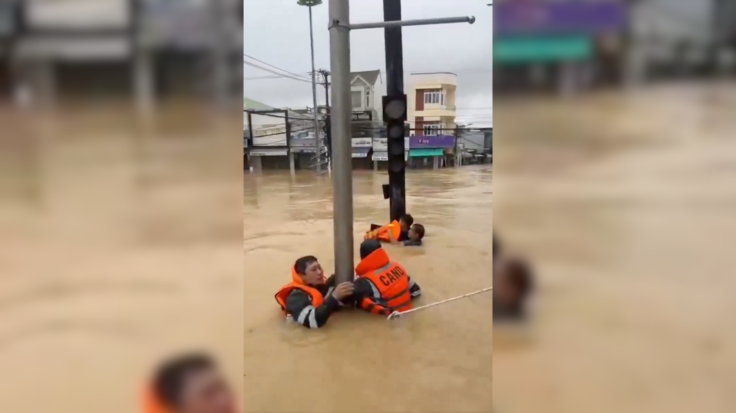After 188 Deaths in Philippines, Typhoon Kalmaegi Tears Through Vietnam's Coastline
Typhoon Kalmaegi leaves nearly 200 dead across Asia as Vietnam reels from landfall

Typhoon Kalmaegi has left a devastating trail of destruction across Southeast Asia, killing 188 people in the Philippines and five in Vietnam, according to the latest official figures from both countries.
The powerful storm, one of the deadliest to strike the region this year, brought torrential rain, flash floods, and destructive winds as it moved from the Philippines to Vietnam late on Thursday.
Kalmaegi's deadly path has displaced thousands, destroyed homes and infrastructure, and sparked renewed concern over the growing strength of tropical storms fuelled by rising global temperatures.
Vietnam Faces Severe Damage After Landfall
The typhoon made landfall in central Vietnam late on Thursday, battering coastal provinces with winds reaching up to 149 km/h (92 mph). The strong gales uprooted trees, ripped off roofs, and left streets blanketed with debris.
Vietnam's disaster management agency said around 2,800 homes were damaged, seven people injured, and more than 1.3 million residents left without electricity. Rail lines in Quang Ngai province were also damaged, disrupting transport across the region.
Authorities have issued warnings of up to 200 millimetres (8 inches) of further rainfall in provinces stretching from Thanh Hoa to Quang Tri, raising the risk of floods and landslides in already saturated terrain.
Currently, powerful waves are crashing along the coast of Hòa Hiệp Ward in Đông Hòa Town, Phú Yên Province, Vietnam, as Typhoon Kalmaegi approaches landfall. pic.twitter.com/YkGEg8FL3a
— Weather Monitor (@WeatherMonitors) November 6, 2025
Desperate Scenes On The Ground
In Gia Lai province, aquaculture operators suffered severe losses as strong waves and flooding devastated shrimp farms and coastal infrastructure, according to reports from Reuters. Local reports described waves reaching up to seven metres, submerging warehouses and damaging equipment worth tens of thousands of pounds.
Across affected areas, residents struggled to restore power and communication. Many gathered around generators to charge phones and share updates on missing relatives. Streets were littered with shattered glass, roofing sheets, and uprooted trees as rescue teams began clearing debris.
Current visuals showing destruction from Xuan Thanh Fishing Village, My An Commune, Gia Lai Province, Vietnam.
— Weather Monitor (@WeatherMonitors) November 7, 2025
Typhoon Kalmaegi has battered Vietnam last night with heavy rain and destruction, leaving at least one dead, while the death toll in the Philippines nears 200. pic.twitter.com/Vf6So76oQ1
Philippines Declares State Of Calamity
Before striking Vietnam, Typhoon Kalmaegi devastated the Philippines, where flash floods and landslides swept through entire communities. According to VietnamPlus, the death toll reached 188, with 135 people missing and 96 others injured.
President Ferdinand Marcos Jr. declared a state of calamity across the country after visiting evacuation centres and promising ongoing government aid.
Thousands remain displaced, and entire neighbourhoods, particularly in Cebu and Talisay City, were obliterated as torrents of mud and debris crashed into homes.
READ MORE: Filipino Families Take Shelter In Caves and Drainage Canals To Seek Safety Amid Typhoon Tino
Military Mobilised As Fears Grow Over More Storms
Vietnam has mobilised 268,000 soldiers, along with 6,000 vehicles and aircraft, to support search-and-rescue operations. Meanwhile, the Philippines' Civil Aviation Authority has placed all airports under high alert as another storm, Typhoon Fung-wong, is forecast to intensify into a super typhoon by Sunday.
Regional experts warn that Kalmaegi's destruction illustrates a dangerous trend — more frequent and more powerful storms due to global warming.
Scientists Warn Of Intensifying Storms
Meteorologists and the World Meteorological Organization (WMO) have linked growing storm severity to rising ocean temperatures, which provide greater energy for tropical cyclones.
Vietnam and the Philippines, both located along the Pacific typhoon belt, experience multiple storms each year, but scientists say they are now stronger and less predictable.
Experts and humanitarian agencies have warned that Kalmaegi underscores Southeast Asia's growing vulnerability to climate-related disasters.
WMO said rising sea surface temperatures are likely to make tropical cyclones in the region more frequent and intense, reinforcing the need for stronger early warning systems and disaster preparedness.
The Long Road To Recovery
As emergency workers clear debris and restore power, both countries face enormous rebuilding challenges. Humanitarian agencies have called for international assistance to deliver food, shelter, and medical supplies to affected communities.
For families like those in Gia Lai and Cebu, the aftermath of Typhoon Kalmaegi is a battle for survival and a stark warning of the intensifying climate crises facing the region
© Copyright IBTimes 2025. All rights reserved.




















